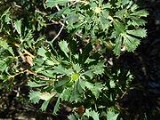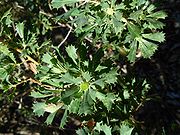
Banksia sessilis var. cygnorum
Encyclopedia
Banksia sessilis var. cygnorum is a variety of Banksia sessilis (Parrot Bush).
, only somewhat smaller, with a concave lower margin, sometimes with small lobes at the base, and often a much darker green. As with other varieties of B. sessilis, the flowers are greenish-yellow. Each head contains from 55 to 65 flowers.
in 1919. Gandoger actually published two names: Dryandra quinquedentata, based on specimen material collected from the Swan River
by Arthur Mills Lea
in 1902; and Dryandra cygnorum, based on material collected by Alexander Morrison
from the Swan River in the vicinity of Melville
, on 31 Jul7 1897. In 1996, Alex George
declared these two names to refer to the same plant, since Gandoger distinguished them only by the width of the leaves, the number of leaf teeth, and the length of the flower head, all of which are quite variable in this variety. He adopted the epithet cygnorum, demoting it to a variety of D. sessilis. Gandoger did not explicitly give an etymology
for the epithet cygnorum, but it is assumed to be from the Latin
cygnorus ("swan"), in reference to the Swan River, from whence it was first collected.
The current name of this variety arose in 2007, when Austin Mast
and Kevin Thiele
transferred Dryandra
into Banksia
; thus the variety's current full name is Banksia sessilis var. cygnorum (Gand.) A.R.Mast & K.R.Thiele.
in the north, to south of Fremantle
. It largely occurs near the coast, in sand over limestone; but it does occur further inland, at Kings Park
and also around Lake Indoon.
 This variety is little known in cultivation. It is suggested that cultivation requirements would be similar to the better-known B. sessilis var. sessilis. Despite being a coastal plant, it has been reported as being frost-resistant down to -7°C.
This variety is little known in cultivation. It is suggested that cultivation requirements would be similar to the better-known B. sessilis var. sessilis. Despite being a coastal plant, it has been reported as being frost-resistant down to -7°C.
Description
It grows as a shrub up to five metres high, with a down of fine hairs on the stems. This variety is has the smallest leaves of any B. sessilis variety, being no more than three centimetres long, and less than two centimetres wide. They are often wedge-shaped with a long, toothless lower margin, and as such are quite similar to those of B. sessilis var. flabellifoliaBanksia sessilis var. flabellifolia
Banksia sessilis var. flabellifolia is a variety of Banksia sessilis .-Description:It grows as a shrub up to five metres high. Unlike other varieties of B. sessilis, it has hairless stems. The leaves are fan shaped, with a long, toothless lower margin, and a toothed end...
, only somewhat smaller, with a concave lower margin, sometimes with small lobes at the base, and often a much darker green. As with other varieties of B. sessilis, the flowers are greenish-yellow. Each head contains from 55 to 65 flowers.
Taxonomy
This variety was first published by Michel GandogerMichel Gandoger
Abbott Jean Michel Gandoger , was a French botanist and mycologist.. Gandoger was born in Arnas, the son of a wealthy vineyard owner in the Beaujolais region. Although he took holy orders at the age of 26, he devoted his life to the study of botany, specializing in the genus Rosa...
in 1919. Gandoger actually published two names: Dryandra quinquedentata, based on specimen material collected from the Swan River
Swan River (Western Australia)
The Swan River estuary flows through the city of Perth, in the south west of Western Australia. Its lower reaches are relatively wide and deep, with few constrictions, while the upper reaches are usually quite narrow and shallow....
by Arthur Mills Lea
Arthur Mills Lea
Arthur Mills Lea was an Australian entomologist.Lea was born in Surry Hills, New South Wales, the second son of Thomas Lea, from Bristol, England, and his wife Cornelia, née Dumbrell, of Sydney....
in 1902; and Dryandra cygnorum, based on material collected by Alexander Morrison
Alexander Morrison (botanist)
Alexander Morrison was the first Government Botanist of Western Australia.Born in Western Dalmeny, Scotland, he began a medicine degree at Edinburgh, but suffered from ill health, prompting him to break his studies and visit Australia. He spent two years in Melbourne before returning to Edinburgh...
from the Swan River in the vicinity of Melville
Melville, Western Australia
Melville is a suburb of Perth, Western Australia located within the likewise named City of Melville....
, on 31 Jul7 1897. In 1996, Alex George
Alex George
Alexander Segger George is a Western Australian botanist. He is the authority on the plant genera Banksia and Dryandra...
declared these two names to refer to the same plant, since Gandoger distinguished them only by the width of the leaves, the number of leaf teeth, and the length of the flower head, all of which are quite variable in this variety. He adopted the epithet cygnorum, demoting it to a variety of D. sessilis. Gandoger did not explicitly give an etymology
Etymology
Etymology is the study of the history of words, their origins, and how their form and meaning have changed over time.For languages with a long written history, etymologists make use of texts in these languages and texts about the languages to gather knowledge about how words were used during...
for the epithet cygnorum, but it is assumed to be from the Latin
Latin
Latin is an Italic language originally spoken in Latium and Ancient Rome. It, along with most European languages, is a descendant of the ancient Proto-Indo-European language. Although it is considered a dead language, a number of scholars and members of the Christian clergy speak it fluently, and...
cygnorus ("swan"), in reference to the Swan River, from whence it was first collected.
The current name of this variety arose in 2007, when Austin Mast
Austin Mast
Austin R. Mast is a research botanist. Born in 1972, he obtained a Ph.D. from the University of Wisconsin–Madison in 2000. He is currently an associate professor within the Department of Biological Science at Florida State University , and has been director of FSU's since August 2003.One of his...
and Kevin Thiele
Kevin Thiele
Kevin R. Thiele is curator of the Western Australian Herbarium. His research interests include the systematics of the plant families Proteaceae, Rhamnaceae and Violaceae, and the conservation ecology of grassy woodland ecosystems...
transferred Dryandra
Dryandra
Banksia ser. Dryandra is a series of 94 species of shrub to small tree in the plant genus Banksia. It was considered a separate genus named Dryandra until early 2007, when it was merged into Banksia on the basis of extensive molecular and morphological evidence that Banksia was paraphyletic with...
into Banksia
Banksia
Banksia is a genus of around 170 species in the plant family Proteaceae. These Australian wildflowers and popular garden plants are easily recognised by their characteristic flower spikes and fruiting "cones" and heads. When it comes to size, banksias range from prostrate woody shrubs to trees up...
; thus the variety's current full name is Banksia sessilis var. cygnorum (Gand.) A.R.Mast & K.R.Thiele.
Distribution and habitat
B. sessilis var. cygnorum occurs along the coast of Western Australia from DongaraDongara, Western Australia
Dongara is a town located 351 km north-northwest of Perth on the Brand Highway. The town is located at the mouth of the Irwin River. In recent years the area has been marketed as the 'Rock lobster capital of Australia'....
in the north, to south of Fremantle
Fremantle, Western Australia
Fremantle is a city in Western Australia, located at the mouth of the Swan River. Fremantle Harbour serves as the port of Perth, the state capital. Fremantle was the first area settled by the Swan River colonists in 1829...
. It largely occurs near the coast, in sand over limestone; but it does occur further inland, at Kings Park
Kings Park, Western Australia
Kings Park is a park located on the western edge of Perth, Western Australia central business district. The park is a mixture of grassed parkland, botanical gardens and natural bushland on Mount Eliza with two thirds of the grounds conserved as native bushland. With panoramic views of the Swan...
and also around Lake Indoon.
Cultivation


